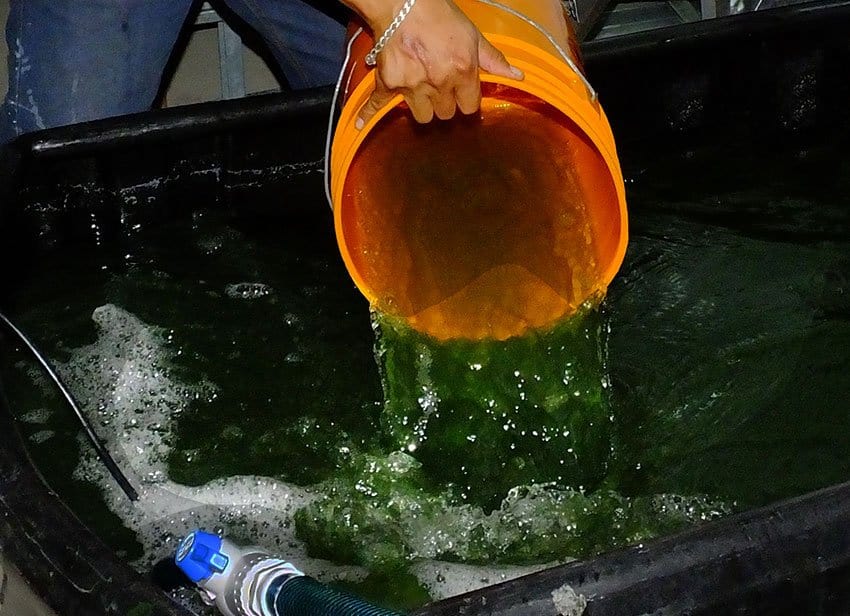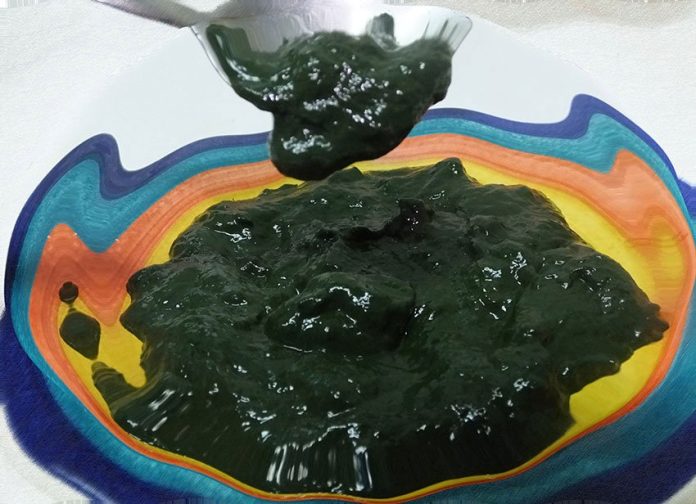The indigenous peoples of Mexico apparently had a nose for superfoods. Before the arrival of the Spaniards, they were happily consuming amaranth and chia, both of which have only recently been rediscovered and made available commercially.
Well, they had a third superfood that is also making a comeback. It’s called spirulina and, according to the United States National Institute of Health, it “became famous” after it was successfully used by NASA as a dietary supplement for astronauts on space missions.
Spirulina looks like algae, but it’s something even more primitive. I first heard the word used when I visited the back yard of my neighbor, Rodrigo Orozco. At the far end of his property there is a big hothouse, which I assumed was for growing vegetables.
“Actually, I’m growing something else in here, something blue-green and slimy,” Orozco told me as he opened the hothouse door. Inside I found 24 huge, translucent vats.
“Inside these is spirulina,” said my neighbor. “It’s a cyanobacterium, one of the first living things to exist on our planet and because it’s able to do photosynthesis, it’s green in color. It also produces oxygen, but curiously, can only live in a very alkaline environment. Thousands of years ago, people in Africa and Mexico noticed it. In Mexico, the Aztecs, especially the runners, consumed it regularly. They called it tecuitlatl, which I am sorry to say, translates as something like ‘rock poop.’”

Orozco told me the Aztecs harvested it by sticking long poles into certain very alkaline lakes and coating the poles with this thick goo which they dried and made into little flat cakes. These cakes were common food in those days and are described by Bernal Díaz del Castillo in his book, The Discovery and Conquest of Mexico. While visiting a market, Díaz observes:
“Fishermen and others were selling little cakes made of something like slime, which they collect from that big lagoon. This they thicken and make into cakes which taste a bit like cheese.”
Just as they frowned upon amaranth (for religious reasons), the Spaniards took a dislike to this “Aztec cheese” and drained many of the alkaline lakes where spirulina grows naturally. So, like many other good native Mexican customs, eating tecuitlatl came to an end after the Conquista and was forgotten.
Orozco went on to describe how a curious event brought spirulina production back to Mexico centuries later. In the 1970s, he says, a company called Sosa Texcoco, the biggest producer of sosa cáustica (caustic soda or lye) in the world, was working in El Lago de Texcoco and at an international convention they complained to other colleagues in the business that they were having problems separating the lye from a pesky green substance growing in the highly alkaline lake.
Hearing this, a Japanese scientist looked at them and said, “You are fools! That green stuff is much more valuable than lye. It’s Arthrospira maxima, commonly called spirulina.”
So, in the early 1970s, Sosa Texcoco gave birth to the company Spirulina Mexicana, which quickly ended up becoming the world’s largest producer of spirulina. But the company was a co-op and suffered from organizational and other problems and eventually went broke.

“And that,” said Orozco with a wry look, “was the end of modern production of spirulina in Mexico.” Today, he says, the biggest producers are in the U.S., South America and Europe.
I asked Rodrigo Orozco how he learned about this obscure Aztec food.
“My wife is a vegan,” he told me, “and the only protein she gets is from seeds like almonds. Then we heard about something called spirulina and the name sounded funny to me. What is this stuff? I never heard of it before. So I Googled it and found it was an amazing sort of superfood, but I was ashamed to discover it was also something very, very Mexican, and yet I had never heard of it.
“I found out the Aztecs used to eat it every day as a common source of protein, so both my wife and I started taking spirulina . . . and I soon experienced a big change in my life. I had more resistance riding my mountain bike than my compañeros and the next day, instead of feeling sore, I felt great. It turned out spirulina is a potent anti-inflammatory.
“Spirulina also seems to be the richest source of protein on the entire planet. Beef and soybeans are nothing in comparison. I also found out it has all the basic amino acids needed by human beings, and it has iron, calcium, magnesium, copper, beta-carotene and the entire B-group of vitamins.
“And your humor changes: you become more positive. Also, I used to have a terrible memory, but now I’ve only got a bad memory: that’s an improvement, believe it or not!”
[soliloquy id="67850"]
Orozco discovered it was not easy to grow spirulina. “You can’t just throw it into a pond and expect it to grow. It’s not an alga but a cyanobacterium, so named for its bluish-green color. I took a course about spirulina, but found out almost nothing about growing it. So I tried on my own for over a year and it kept dying on me.
“Finally I found somebody who offered courses on the growing of it and today I am harvesting around four kilos per week. Rather than drying it, which I think reduces its benefits, I press it and freeze it in small, thin rectangles which look a bit like Andes Mints. To take one, you just drop the ‘mint’ into a glass of your favorite juice, like an ice cube. Since the spirulina has very little taste of its own, you hardly notice it’s in your drink.”
Rodrigo Orozco’s product is marketed as Corazón de Verde Spirulina Fresca, distributed by Chocolates Costanzo in Guadalajara.
One of the most prominent promoters of Spirulina is Jean-Paul Jourdan, a French professor of history and author of the book Grow Your Own Spirulina. Fascinated with this miraculous micro-algae, Jourdan spent more than 12 years working on the development of low-cost techniques for spirulina production in Africa. It should be noted, by the way, that spirulina is the only foodstuff ever approved by the United Nations for fighting malnutrition.
Jourdan demonstrated that people anywhere could make a hole in the ground, seal it with plastic, fill it with water, and make the water alkaline with easy-to-find ingredients such as urine and rusty iron.
As Rodrigo Orozco found out, growing your own spirulina can be daunting at first, but the Spirulina Academy says, “after a few tries, it gets much easier, and in no time you’ll be growing and eating fresh spirulina!”
While working in Oman, I was shown stromatolites in the limestone. These I was told were the oldest fossils in the world. Now, thanks to my enterprising neighbor, I’ve learned that those were fossils of the oldest foodstuff on earth: microbial mats, mostly composed of cyanobacteria which, to top it all off, are credited with changing the atmosphere of the earth hundreds of millions of years ago from 1% oxygen to around 20%, as it is today.
So I can’t disagree with my neighbor Rodrigo when he says, “¡Como la spirulina, no hay nada más! – there is simply nothing else quite like spirulina.”
The writer has lived near Guadalajara, Jalisco, for more than 30 years and is the author of A Guide to West Mexico’s Guachimontones and Surrounding Area and co-author of Outdoors in Western Mexico. More of his writing can be found on his website.
